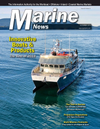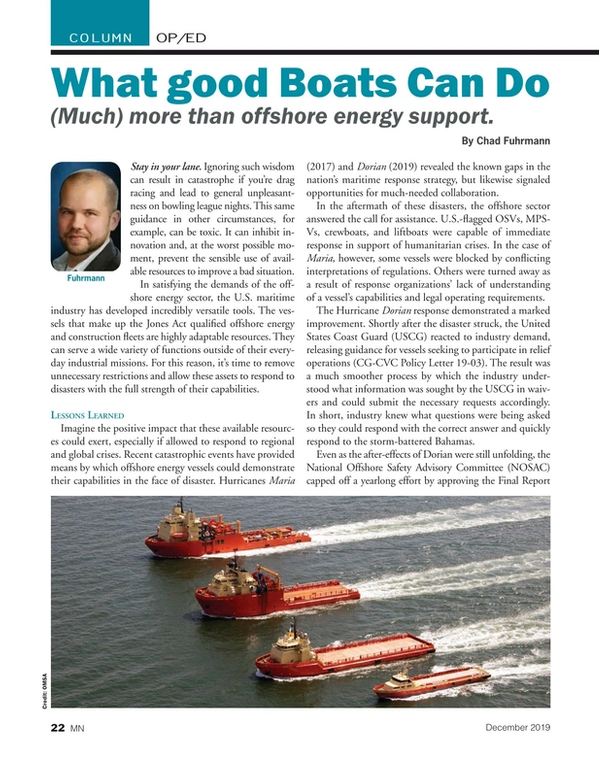
Op/Ed: What Good Boats Can Do
Stay in your lane. Ignoring such wisdom can result in catastrophe if you’re drag racing and lead to general unpleasantness on bowling league nights. This same guidance in other circumstances, for example, can be toxic. It can inhibit innovation and, at the worst possible moment, prevent the sensible use of available resources to improve a bad situation.
In satisfying the demands of the offshore energy sector, the U.S. maritime industry has developed incredibly versatile tools. The vessels that make up the Jones Act qualified offshore energy and construction fleets are highly adaptable resources. They can serve a wide variety of functions outside of their everyday industrial missions. For this reason, it’s time to remove unnecessary restrictions and allow these assets to respond to disasters with the full strength of their capabilities.
Lessons learned
Imagine the positive impact that these available resources could exert, especially if allowed to respond to regional and global crises. Recent catastrophic events have provided means by which offshore energy vessels could demonstrate their capabilities in the face of disaster. Hurricanes Maria (2017) and Dorian (2019) revealed the known gaps in the nation’s maritime response strategy, but likewise signaled opportunities for much-needed collaboration.
In the aftermath of these disasters, the offshore sector answered the call for assistance. U.S.-flagged offshore support vessels (OSV), multipuropose support vessels (MPSV), crewboats and liftboats were capable of immediate response in support of humanitarian crises. In the case of Maria, however, some vessels were blocked by conflicting interpretations of regulations. Others were turned away as a result of response organizations’ lack of understanding of a vessel’s capabilities and legal operating requirements.
The Hurricane Dorian response demonstrated a marked improvement. Shortly after the disaster struck, the United States Coast Guard (USCG) reacted to industry demand, releasing guidance for vessels seeking to participate in relief operations (CG-CVC Policy Letter 19-03). The result was a much smoother process by which the industry understood what information was sought by the USCG in waivers and could submit the necessary requests accordingly. In short, industry knew what questions were being asked so they could respond with the correct answer and quickly respond to the storm-battered Bahamas.
Even as the after-effects of Dorian were still unfolding, the National Offshore Safety Advisory Committee (NOSAC) capped off a yearlong effort by approving the Final Report of the Restoration and Recovery Activities Subcommittee. Within its recommendations, the report represented a pioneering step in the application of versatile offshore assets for crisis response with the creation of the Response, Restoration and Recovery Vessel (“Triple-R”, or TRV) endorsement. This endorsement and related capability matrix were recommended for integration into the USCG Marine Information for Safety and Law Enforcement (MISLE) system for cross referencing with the needs of the response organization.
This endorsement would be assigned based on USCG vetting of the disaster related activities of which a vessel is capable without significant changes to its design. Temporary in nature, the endorsement would supersede certain restrictions imposed by regulatory restrictions to allow vessels to respond to a disaster, but only within the scope of their capabilities. This would prevent vessel owners from needing to request a USCG waiver, thereby and all but eliminating any delays in a vessel’s ability to respond.
The Offshore Marine Service Association (OMSA) and its members recognized the potential of the approach espoused within NOSAC’s recommendations. As Dorian thrashed the Bahamas, the Association applied a version of the matrix capability assessment. OMSA was able to provide a database of over 50 immediately available assets to response organizations including the USCG and the Federal Emergency Management Agency (FEMA). This database demonstrated the multiple capabilities of marine assets that were instantly available for response operations.
Steward–ships
Point A to B and back again. The transport of goods and services serves as the single industrial mission common to virtually all marine vessels.
What sets many vessels in the offshore energy and marine construction industries apart is that they are capable of so much more. During times of crisis, response organizations require multiple resources for myriad purposes, all of which U.S.-flagged vessels in the above-mentioned industries are proficient in providing.
Since the release of the NOSAC report, OMSA and its members have continued to engage the USCG and FEMA in discussions about the industry’s capabilities and the Nation’s response requirements. The impetus behind the effort was hurricane response, but the recommendations can improve the maritime response strategies for any crisis scenario. These methods are designed to work across agency and industry boundaries.
Do not stay in your lane!
The capabilities required in any disaster response involve fueling, lifting, transport and firefighting. Or, in other words, the arguably perfect description of the daily activities of typical offshore energy or marine construction vessels. In fact, the utilitarian nature of a modern OSV, MPSV and/or crewboat allows it to execute several of these functions without deviating from its core design. Where changes are necessary, the modularity of such equipment as portable accommodation and industrial modules makes mission variations similarly easy. Any unique modifications required for communications, housing and emergency power functions can be affected in little more time than would constitute a typical port stay.
This adaptability, in combination with the temporary reprieve from regulatory restrictions offered by the proposed TRV endorsement, can better position the industry to respond to crises. But nothing can progress without further cooperation from regulators. The Coast Guard initiated the NOSAC Task Statement in response to pressure from OMSA and Congressional leaders such as U.S. Senator Bill Cassidy (R-La.). However, there was also recognition of the need for response agencies to be more proactive in understanding the response capabilities already available.
Of course, an important part of the U.S. Coast Guard’s myriad missions is to ensure maritime safety. Within that scope it must enforce regulations including those which may restrict the ability of certain vessels to respond to disasters. This mission, however, must be balanced with its vision of preparedness to serve and protect the Nation’s citizens and interests. During a disaster, strict enforcement should not impede critical humanitarian objectives, particularly if thoroughly vetted, capable assets are available to assist.
Read Op/Ed: What Good Boats Can Do in Pdf, Flash or Html5 edition of December 2019 Marine News
Other stories from December 2019 issue
Content
- INSIGHTS: Niels Aalund page: 14
- Op/Ed: What Good Boats Can Do page: 22
- The Good, the Bad and the Undeniably Ugly page: 24
- The Mighty Mississippi: Taming the Bull page: 26
- Beware of the Nominal Entity page: 28
- It’s Time to Upgrade to a Marine Evacuation System page: 30
- NOx Control: Should Certain Vessels Get a Break? page: 34
- The Top 10 Workboat Stories for 2019 page: 36
- For Fireboats, The Heat is On page: 46


